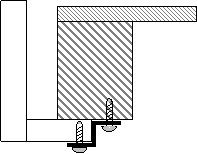 Photo 1
Photo 1
Commercial canvas clips mounted in shallow wood rabbet
When a stretched canvas or cradled box is too deep for the selected frame…there's a problem, how exactly do you get it to stay in there? Offset clips are the very best way to hold paintings on rigid backings into picture frames, though artists have come up with many other solutions, including bent nails.
Canvas Clips
Canvas clips, or bar clips, are a popular choice for artists to hold canvases that stick out beyond the back of the frame. Though this commercial solution is far better than using a bent nail, it is still not very secure, and most definitely not the professional solution (photo 1). They are a simple, one piece spring steel clip designed to fit 1½" to 1¾" stretcher bars, which are reusable, easy to install, and require no tools, adhesives or fasteners. Canvas clips wedge into the gap between the stretcher and the frame, and then by pressing down, the teeth pierce the inside edge of the frame rabbet. The opposite end of the clip snaps down to grab the inside of the stretcher bar to hold it in the frame. Though one clip per side is suggested by suppliers as adequate for installation, the corners of a larger canvas may warp out making this a much less secure mounting option. If you are selling framed canvases it is in your best interest—and that of your collector—to properly frame any original canvas prior to display and sale.
 Photo 1
Photo 1
Commercial canvas clips mounted in shallow wood rabbet
 Photo 2
Photo 2
Offset clips ⅛" to 1¼".
Offset Clips
This z-shaped hardware is also referred to as an offset, canvas offset, offset mounting clip, z-clip, or frame clip. It is a zinc plated stair-step hardware with rounded corners designed for use when the depth of a picture frame is too shallow for the art or canvas it is framing. They are perfect for mounting boxes and stretched canvases into float frames (diagram 1) and are far superior and more professional than using brads or staples. Longer offsets can be used to screw into the frame and cradle horizontally to prevent screw heads from touching the wall (diagram 2).
 Diagram 1
Diagram 1
A ⅜" clip is used to hold the cradled box into a float frame.
 Diagram 2
Diagram 2
Cradled box in deep float frame held inside frame back.
They are available ⅛", ¼", ⅜", ½", ¾", 1" and 1¼" as shown in photo 2, and come with and without holes in either end, though the holes are the best option. They are generally affixed with #6 pan or round head metal screws at a screw length long enough to hold soundly while not threading through the art board or frame. The smallest ⅛" offset may even be flattened as a screw plate to install any canvas that is even with the back edge of the frame rabbet.
At least four offset clips should be used per small painting, two on top and two on bottom. Placing additional clips on the center of the additional short sides may also be a good idea, and use more as the painting gets larger (diagram 3). Secure the offset clip into the picture frame moulding through one of the holes in the clip, but screwing directly into the art is not advised (photo 3). Though many clips come with two holes in them. The second hole is used when stacking picture frames or liners.
 Diagram 3
Diagram 3
X designates offset clip, arrow is added side clip.
 Photo 3
Photo 3
Masonite original held with ¼" offset and 3M clear bumper.
The ⅜" offsets were padded with 3M clear bumpers to hold the Masonite panel and prevent it from shifting. Both the texture on the back of the Masonite and by placing three per side, the art is solidly held with a 3/32" space surrounding it in the frame. Obviously a screw could not be used as it would have both shredded the panel and may have passed through to the front of the egg tempera original.
END
Copyright © 2012 Chris A Paschke
For more articles on mounting basics look under the mounting section in Articles by Subject.
There is a special section in the library for all past IEA Framing Matters articles from Wax-On!
Additional information on all types of mounting is found in:
The Mounting and Laminating Handbook, Second Edition, 2002,
The Mounting And Laminating Handbook, Third Edition, 2008 and
Creative Mounting, Wrapping, And Laminating, 2000 will teach you everything you need to know about getting the most from your dry mount equipment and materials as an innovative frame designer.
All books are available from Designs Ink Publishing through this website.
Chris A Paschke, CPF GCF
Designs Ink
Designs Ink Publishing
785 Tucker Road, Suite G-183
Tehachapi, CA 93561
P 661-821-2188
chris@designsinkart.com